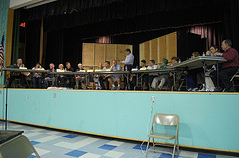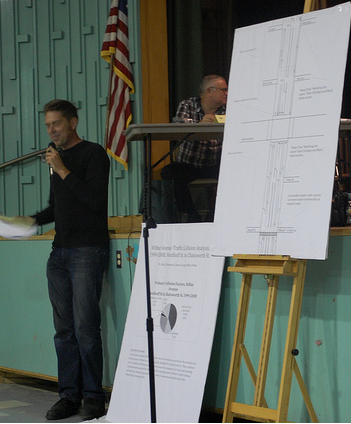Against All Odds, the Wilbur Road Diet Is Staying (for Now)
8:59 AM PDT on March 16, 2011
For eight months now, the LADOT has been taking shots in the Valley over the a two mile road diet on Wilbur Avenue. Between Nordhoff and Chatsworth, Wilbur went from two lanes in both directions to one lane in each direction, a left turn lane, and bike lanes on both sides. Last night, representatives of the Northridge and Porter Ranch Neighborhood Councils, in an official and deciding vote, voted to leave the current road configuration as it was instead of repainting the road to a compromise plan created by the LADOT and a Wilbur Working Group. There's a lot of potential headlines from this meeting, so I'll do my best to give each of them their due.
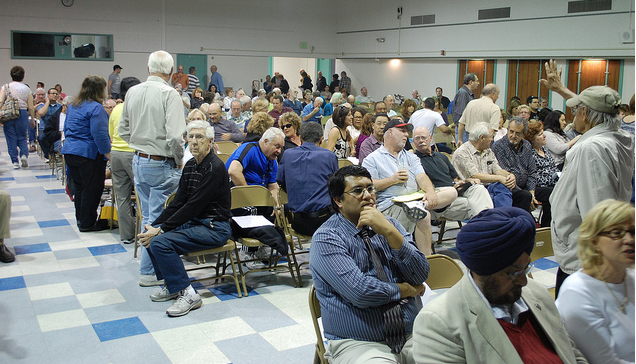
Roughly 450 people packed in to the auditorium at Noble Middle School. A guess as to the allegiance of the audience would be a 65/35 split in favor of ending the entire diet at the peak of the meeting. When the audience shrunk by the end to about a third of the original audience, it was probably a 65/35 split the other way. While emotions ran high throughout the evening, a hand tally on my computer showed that speakers in favor of the Diet were four times as likely to be interrupted by booing, catcalls, and shouting than those opposed. Let's be clear, the majority of the audience was well behaved, whether they agreed or disagreed with the diet. However, the hottest of the hotheads seemed to be on one side of the debate.
There was also a clear geographical divide in the audience. Most of those in attendance lived in the Porter Ranch Neighborhood, located North of the diet, with a minority from the area effected by the diet. At one point a commented asked for a show of hands for who lived South of Chatsworth, where the Road Diet started. I would estimate 15-20% of the audience, and two or three Neighborhood Council Members raised their hands. To their credit, the Porter Ranch Neighborhood Council worked hard to pump up attendance with multiple-emails on the meeting going out daily and robo-calls reaching those without email addresses on file.
You can read about the LADOT's compromise plan here or see a rendering of it here. Basically, the compromise plan would have restored the four lane configuration north of Devonshire and have the diet return 650 feet south of the Devoshire/Wilbur intersection.
Headline #1 Strange Public Process Leads to Strange Result
While it's certainly true that the joint Council meeting voted to preserve the diet instead of the LADOT's plan, it's equally true that given a chance to vote straight up or down on preserving the diet or to go back to its original unsafe and speedy four lane configuration, they would have chosen speed over safety in a heartbeat. As Tom Johnson, president of the Northridge Neighborhood Council stated before the public comment period, "We have a major consensus that the road should go back to four lanes.”
We've previously discussed the strange process leading to the vote, but the meeting itself was an even odder affair. Newly minted Councilman-Elect Mitch Englander and a representative from the city's Department of Neighborhood Empowerment both stated that for the LADOT's plan to pass the Neighborhood Councils it would need a majority of "yes" votes from those Neighborhood Council Members present. Basically, an "abstention" was as good as a no vote. The final vote on the LADOT's plan was nine in favor, three opposed, and seven abstentions.
I've never heard of an abstention counting as a "no" vote but rather as a vote that didn't count either way. Abstentions are usually used when an elected official has a conflict or insufficient information to make an intelligent vote. That being said, it would be even more strange to change the meaning of the abstention vote now, after the Council were told that they were, in effect, voting no. Assuming Englander, and the LADOT were both telling the truth, this marks the end of the road for the debate on the Wilbur Road Diet and it's going to stay as it is.
But if you honestly believe this is the end, well, you're probably in for a rude awakening.
Headline #2 LADOT Leads with Bike Lanes, Takes It on the Chin
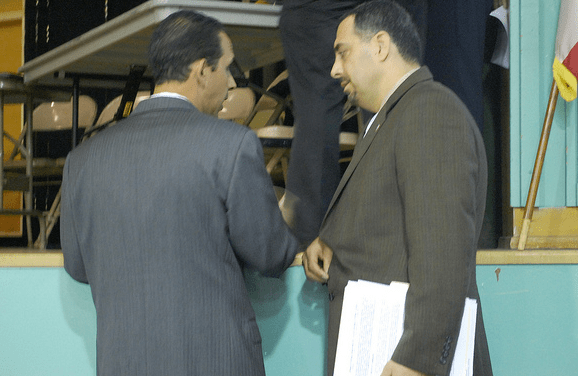
Despite months of insisting that the Bike Lanes that were installed on Wilbur Avenue were a side product of the Road Diet, and not the reason for the change, LADOT Interim General Manager spent much of his presentation explaining that the city has a unanimously passed bike plan, signed by the Mayor, and that they can't remove the lanes so any new configuration will keep the bike lanes. Sedadi was repeatedly heckled and shouted down by the angriest in the audience.
This new bike lane reality makes it impossible to completely roll back the road diet, because South of Devonshire the road is not wide enough for four traffic lanes and two bike lanes. We should note that just because the diet can't end because the Department can't take out bike lanes that are now in the plan, the plan was passed two weeks ago. The LADOT has stated many times in the last eight months that the diet was because of the unsafe nature of Wilbur Avenue.
Towards the end of the question and answer with the Neighborhood Council, Sedadi finally brought up the safety reasons for the current street configuration. " We have to stress that there are safety issues. Left hand turn lanes are important."
Yet even the mention that the road was unsafe wasn't enough for some. Sedadi's calls for a safer road received a scattering of boos. Safety issues, they booed safety issues. Still, it seems arguing safety, as would be done more forcefully later, would have been a much stronger argument than arguing that the city has embraced bike lanes and they can't be taken out because powerful people want bike lanes.
LADOT was so unpopular in the room that Englander got two of the loudest applause lines of the night when he joked that "He didn't want to throw (former LADOT General Manager) Robinson completely under a bus, unless that bus is on Wilbur Avenue." Later he stated that, "His (outgoing Councilman Greig Smith) position is firm, his position is to put it back the way it was identical to the way it was...My position is to disband the DOT, but that’s another issue."
To be fair, nobody defended the decision to re-paint the road back in August without doing community outreach, a stated reason why drivers are so upset in the area. Englander blasted it, Sedadi, even though he didn't make the decision, apologized for it. It was a bad call, and hopefully LADOT learned a lesson from this public relations disaster.
Headline #3 LADOT Stands Firm
Are we witnessing a new LADOT?
In January and February, livability advocates witnessed LADOT Senior Transportation Engineer Kang Hu stand up to Zev Yaroslavsky and Bill Rosendahl when they were pressuring him to back the segmenting of the Wilshire Bus Only Lanes proposal. Last night, they got to witness Sedadi and Assistant General Manager John Fisher stand up for road diets and bicycle lanes.
Trying to box-in the LADOT, one Neighborhood Council Member from Porter Ranch asked Sedadi the designation of Wilbur Avenue. When he answered that it was a secondary highway, they asked for the definition of a secondary highway. Sedadi handed over the microphone to Fisher.
"Secondary Highways are intended to carry some through traffic as well as local traffic. Also to accommodate the bicycle backbone network within the city,“ Fisher responded to cheers. “Major highways, such as Tampa Avenue, are to accommodate through traffic,” he continued to boos. Now the crowd was booing engineering standards.
LADOT didn't take the bait when offered a chance to give ammunition to the car culture warriors or backoff their assertion that the compromise plan was one that would balance the safety of users with the speed "needs" of through traffic.
Headline #4 Safety an Important Issue, But It Won' Turn a Mob
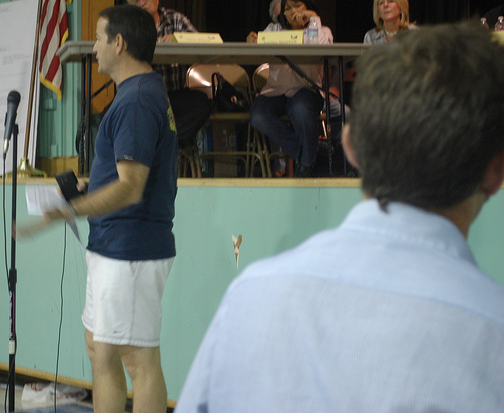
The most galling aspect of the evening was the reaction of a handful of car driving commuters who continually tried to intimidate LADOT staff, those testifying and the Neighborhood Councils by booing, cat calling, and trying to shout down anyone who disagreed with them. LADOT staff was booed for calling the four lane configuration unsafe. Don Ward was booed and screamed at to "move somewhere else" when he talked about the dangerous conditions outside the house his family lived in for two decades. A statistical review of the crashes and deaths caused by the original configuration were dismissed as scare tactics.
Occasional bouts of shame would hit the angriest of the drivers for a second, such as when the calm and smiling Ward inquired as to whether people would like it if he sped in front of their house or when Alex Thompson, who along with Jason Leung and Mihai Peteu completed a statistical analysis of crash trends in the affected area, inquired as to how many deaths were acceptable to maintain people's commutes. However, even the average death or one person every two years along this brief stretch of road wasn't enough to stop someone from yelling at Thompson that "We could end all transportation and reduce the accidents to zero."
But some facts didn't change the callousness of the handful of drivers at all. After LAPD Sargent David Krumer responded to a question by Thompson as to the safety of the road (are there less crashes now than before the diet) by stating that the number of "incidents" was down, the very next speaker asserted that "everyone wants the road to go back to the way it was."
For the record, the safety figures for Wilbur before the diet in this two mile area are ugly. 234 reported collisions and five deaths on two miles of road are extremely high numbers for that small a stretch of road. Drivers kept asserting that the road was less safe now than before the crash. If we assume their anecdotal evidence is correct and not the statistical evidence provided by Thompson, Leung, Peteu and Krumer it's impossible not to note that the reasons for the reduced safety is lawless and reckless driver behavior.
So does the diet address the crashes? Yes. One angry driver shouted at Ward that he should "Get real. 13% of the accidents are caused by speed." While that is true, 40% were caused by cars turning left getting rear ended or rushing the turn and getting hit from the side. I have to imagine that the left hand turn lane available at every intersection in both directions created by the diet has done wonders in reducing that number.
While parts of the audience acted like unruly children throughout the night, there was some movement by those people that weren't experiencing road rage sitting in their auditorium seats. Thompson brought hundreds of copies of his analysis (which we'll post when we get an electronic copy) and audience members could be seen reading them throughout the presentation.
Several drivers talked about the "need" to illegally drive in a bike lane so that they could "get around" the congestion created "by the diet." Put another way, many of the drivers rationalized that it was o.k. to break the law and imperil cyclists' (and incidentally their own) lives to shave a couple of minutes off their commute. I wonder how many of these same people would scream holy murder when a cyclist runs a red light or stop sign after admitting their own dangerous and illegal driving behavior.
Oddly, the sentiment that the Road Diet and bike lanes were creating a safety hazard was not shared by the cyclists using the bike lane. Nine cyclists testified about their experience riding on the bike lanes and all of them claimed it was more safe. Several other drivers who claim to bike often said they avoid the lanes for safety reasons, but everyone who actually used the lanes claimed they were more safe now then before.
Of course, that was before they heard their neighbors rationalize driving in those lanes.
The best argument for reducing the diet is that cut through traffic is increasing on parallel streets, creating what is basically a new secondary highway on what was a local, residential, street. As I wondered when a similar situation popped up in Westwood, if that's really the main concern, more traffic on another local street, why not advocate for traffic calming on that street to push the traffic back to the secondary highway or even larger streets close by. The appropriate response to a negative secondary impact of a project designed to make a road safer is not to demand that the other road becomes dangerous again.
Headline #5 Mitch Englander Is Our Chuck Schumer
In addition to blaming Rita Robinson for all of the controversy created by the Road Diet, and repeatedly mocking and baiting the LADOT; Councilman-Elect Englander went out of his way to also mock bicycling and turned a deaf ear to any safety arguments that were made about the existing configuration, referring to it as "A horrific thing that has happened to the community." That's right, a plan to reduce traffic collisions and deaths in an area is a "horrific thing."
Later, Englander admitted that he has to drive on Wilbur "three to four times a day" because his house is located at the north end of the project and Smith's office is near the south end. (Note: Streetsblog doesn't reveal the address of public officials, even if its given on the record.) When someone from the audience asked why he doesn't try riding a bike, the soon-to-be Councilman responded with a roll of the eyes and that "I’ll see you out there on my bicycle.”
It seemed that the questioner might as well have asked why Englander didn't fly on his hoverboard down to the office. Bike two and a half miles on a relatively flat and wide street "three to four times a day?" Heavens forbid.
Headline #6 LADOT May Have Stood Firm, But the Compromise Plan Sucked
As stated, the compromise plan would have basically just moved the created traffic jam from Chatsworth down to Devonshire without doing anything else to slow down traffic. As angry and callous as the bulk of the audience seemed at times, many expressed willingness to compromise on traffic calming if the road were restored to four lanes in both directions, a proposal pushed by Ward. In other words, the bike lanes would be removed, the original striping would go back, but a series of bump outs, crosswalks and stop signs would calm traffic and not destroy the connections between communities that the diet created.
The tradeoff, as Ward proposed it, would be slower speed for returned capacity. While not thrilled about the concept, people did at least listen to Ward's plan.
None of these ideas were taken seriously in the LADOT compromise plan. Instead, the Councils were told to take it or leave it. In a major upset, they decided to leave it.
Stay in touch
Sign up for our free newsletter
More from Streetsblog Los Angeles
Metro Board Funds Free Student Transit Pass Program through July 2025
Metro student free passes funded another year - plus other updates from today's Metro board meeting
Eyes on the Street: New Lincoln Park Avenue Bike Lanes
The recently installed 1.25-mile long bikeway spans Lincoln Park Avenue, Flora Avenue, and Sierra Street - it's arguably the first new bike facility of the Measure HLA era
